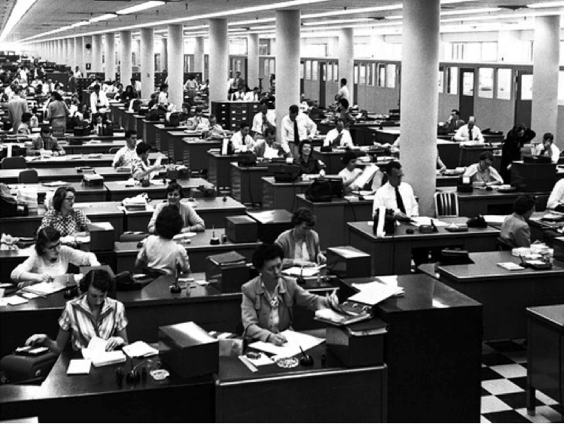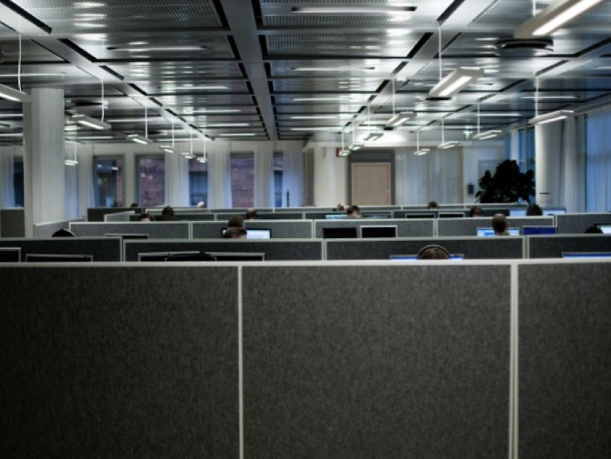If you missed Elizabeth’s webinar, Trailblazing Facilities For Tomorrow’s Workforce, don’t worry! We have the complete recap here, along with a recording of the presentation.
Trailblazing Facilities for Tomorrow’s Workforce
The History Of The Changing Workplace
The workplace is changing dramatically and at a fearsome pace, with significant transformations in where and how people work. Technology-fluent workers, smart buildings, the cloud and other mobility enablers—these trends and more are turning facilities management upside down. The very meaning of “office” is changing. If the office is where we work, and we work everywhere, the office is everywhere.
Take a look at these two vintage offices. The first on the left is from 1950. The open-concept floor plan allows for communication. It’s still a bit rigid, but it allows coworkers to engage with one another. Then around 1970, the walls come up. Which allowed for privacy, but inhibited communication, and isolated workers in gray, uninspiring boxes. Both of these styles have some functioning points, but they’re not perfect.


Today, workplaces are changing yet again. Employees want to be collaborative, while also allowing for quiet working space. The best workspaces today must be flexible, mobile and managed by technology that gives workers what they need to be successful.
Expectations of younger workers are also changing fast. Today’s twenty-somethings grew up with the technology that older folks watched being born. They understand it. They know how to use it. They expect it. The whole world of work they are entering is quite different from what work used to be.
Generation Y
By 2015, these Generation Y digital natives will comprise 50% of the workforce. Their idea of work is much different then the generations before them. This new generation demands new ways of working, that companies need to prepare for.
Recent studies tend to show that:
- They expect to be able to work from anywhere
- Their work lives and social lives are highly blended
- They want and value frequent feedback
- They appreciate managers who display vulnerability
The Bersin/Deloitte study also points out that highly skilled workers are in great demand as baby boomers retire in large volumes – making it critical for organizations to become talent magnets and build passion among these employees. The best and the brightest in this demographic will not be happy with the traditional workplace.
Incidentally, forty-year-olds to seventy-year-olds, working closely with this new generation of smart, motivated, and extremely connected people have adopted some of the habits and aspirations of Generation Y.
The structure, content, and process of work have all changed, work is now:
- More team-based and collaborative
- More dependent on social skills
- More dependent on technological competence
- More mobile and less dependent on geography
Where And How We Work Is Changing
Bud Klipa, General Manager of Steelcase, a manufacturer of office furniture says, “Companies aren’t just slashing real estate footprints. They’re looking for creative ways to use the space they have and shifting some work to home offices, third places, satellite offices and other spaces.”

Also, Americans are spending more time at work than ever before. In fact, U.S. workers spend more time at work than anyone else in the world. The average work week for an American worker is up to about 46 hours, adding up to 378 more hours per year than the average German worker, for example.
Clearly, given the dramatic changes in the whole concept of what the office and the workplace are, workplace managers need to be able to manage multiple locations and a wide scope of services and assets on the fly.
Wide Open Workspace
Don Traweek and Elizabeth Dukes have written a book about this transformation that is touching companies around the globe. The book, titled Wide Open Workspace, is all about productivity and how it’s achieved in the contemporary business environment.

They used the enduring image of the archetypal American cowboy of the 19th century as a metaphor and parallel between the innovation, trailblazing, and completely new thinking going on among today’s human resources, information technology and facilities management professionals. The cowboy had to be inventive, nimble, courageous, and determined to get those cattle to market safely and profitably. Today’s workers and the infrastructure that supports them likewise need to embody all of these qualities in order to serve their markets and customers.
Facilities Management used to be about keeping the office building warm, clean, and stocked with office supplies. Now, Facilities Managers handle facilities that can be anywhere and everywhere in the world, making sure workers have what they need to do their jobs – including great spaces where HR managers can interview people for the facilities and IT departments.
Today’s CEOs, CFOs and facilities managers often recognize this and are keenly interested in new concepts and create more efficient workspaces in order to reduce the overall spend on real estate. This includes promoting worker mobility and investing in technology. While the corporation increases productivity and reduces the cost of hosting workers, employees can be more productive and experience better work/life balance.
Here are some of the functions that today are being dramatically altered by technology:
- Room Reservations
- Space Management
- Move Management
- Facilities Maintenance
- Asset Tracking
- Monitoring Supplies
- Tracking Visitors
- Mailroom Management
- Copy & Print Services
- Managing Files
The fact is that there is simply no going back to the closed workspace. The days of the giant cube farm are as over as the days of polished mahogany office doors with names stenciled in gold. Technology, globalization, and a new generation in the workforce have changed all that permanently. The wide-open workspace is here to stay. The changes are exciting, and they challenge all of us to understand them and embrace them.
